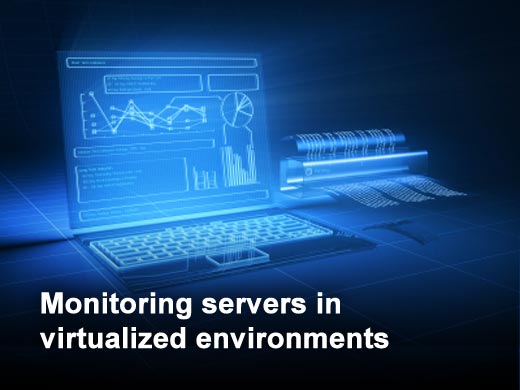The role of servers in your organization has changed substantially — with their uses, requirements, and complexity all increasing dramatically in recent years. Many of the traditional tools and techniques that worked in the past don’t suffice any more. Consequently, server monitoring presents several critical battles in today’s demanding environments. Nimsoft has identified some of the most pressing challenges administrators face in ensuring optimal server performance, and offers insights into the tools and strategies required to address these demands.
Click through for five critical battles administrators routinely face in monitoring server performance, as well as ways to win the war, as identified by Nimsoft.
Your Battle
As your organization grows, so too do the demands. If only your headcount and resources kept pace. Ultimately, administrators need to do a lot more, with a lot less. For example, analysts estimate that, through manual administration, one full-time employee can manage 11 UNIX servers or 30 Windows-based servers. For a 1000 server environment, this could translate to approximately 30 to 100 full-time server administrators. This is headcount that most businesses simply cannot afford to hire and retain.
What You Need to Win
Automating the monitoring of servers is one approach that can pay huge dividends in increasing the number of servers one administrator can manage. This needs to include routine automated monitoring of performance and availability metrics, as well as automated alerts and reporting. Look for server monitoring products that offer an efficient code base and robust functionality that enable you to manage more systems, more users, and more data.
Your Battle
Whether through acquisition, merger, or evolving business needs, when your organization starts growing, your server infrastructure very suddenly starts looking a lot less homogenous. Your infrastructure now undoubtedly includes a mix of Windows, Linux, UNIX, Netware, AS400, and more. While monitoring a unified set of servers can be challenging, administering this heterogeneous mix can feel downright impossible.
What You Need to Win
To overcome the challenge of monitoring servers in a heterogeneous environment, you need a comprehensive, platform-agnostic monitoring solution, one that can be used to monitor every type of server and OS in your organization. With the right multi-platform monitoring tool in place, platform-specific variances can be masked from administrators, presenting a consistent monitoring interface for the entire infrastructure.
Your Battle
Imagine this scenario. An end user has just called to say that a core business application is down. After quickly analyzing the associated servers, you see they’re up and running. Then what? Or what happens if you hear customers are complaining about slow response times. You see the server is operating at 80% of capacity. Is that the issue? How do you know?
What You Need to Win
In these scenarios, monitoring associated servers is only part of the story. Servers are part of a complex ecosystem, one that’s comprised of applications, databases, network devices, and more. In today’s competitive business landscape, application monitoring is a must have, especially in the context of end user transactions and service levels.
To do this monitoring, you’ll need a single solution that can encompass all aspects of the infrastructure and provide a cohesive view into the service levels being received, and, if performance issues or outages occur, a fast and precise way of determining what the issue is and how to fix it.
Your Battle
In spite of all its benefits, virtualization presents administrators with significant challenges from a monitoring perspective. Virtualized environments represent an ecosystem of interrelated parts, all of which must be functioning optimally to ensure that business applications remain available. When virtualization gets implemented, an entirely new layer of “moving parts” gets added to the mix, and dramatically increases the complexity of monitoring servers and the infrastructure upon which they rely.
What You Need to Win
Administrators need a broad solution that can monitor all the servers, hosts, applications, databases, networking services, and network devices — as well as virtualization systems like VMware. By combining this broad infrastructure coverage with extensive support for the VMware environment, an effective monitoring solution enables your organization to fully optimize its VMware investments and better ensure the highest service levels.
Look for a solution that can collect an extensive number of health checks in VMware environments. You can then easily leverage this data to understand the status of the VMware environment, and get the information you need to more proactively manage the infrastructure. Finally, look for a product that delivers service level management capabilities so you can more effectively ensure that the business applications hosted in these virtualized environments are in compliance with service level agreements.
Your Battle
After large investments in hardware, one thing typically happens: More and more hardware is purchased and installed. While the term “throwing hardware at a problem” is used often, it is often all that hardware that starts to be the problem. In addition to the upfront investment, managing and supporting this increasing number of systems is increasingly time consuming and costly. Yet all too often, each individual resource is underutilized.
What You Need to Win
With effective server resource monitoring and reporting, you can identify those servers with underutilized resources and make them available for allocation as needed to more fully maximize existing investments and avoid unnecessary expenditures. To manage resource utilization effectively, you need trend reporting solutions that afford better visibility into metrics on CPU, memory, and disk/storage. You also require insights into how these metrics are potentially affecting the service levels end users receive.
Look for solutions that can monitor CPU, memory, or number of threads rises above, or falls below defined threshold values. Additionally, ensure your solution can monitor expected user-run processes and ensure the proper number of process instances are running.








